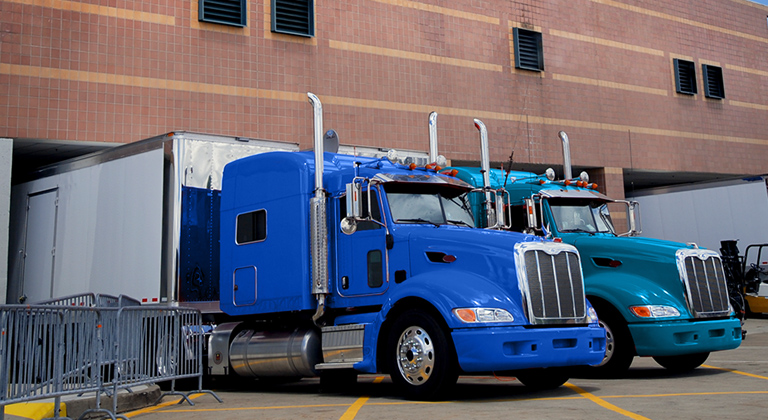Truck loading safety tips
Securing truck loads for safe transport
Getting your product to customers is a big step in your manufacturing process. That means taking some extra time and precautions to make sure the truck ride goes smoothly. We have some tips to help you.
Improper loading techniques can lead to weight and balance problems and can hurt vehicle performance—including steering, braking, and speed control. And if the cargo isn’t secured properly, you could experience shifting loads, loss of vehicle control, and other road hazards. All of these problems often become a contributing factor in truck accidents.
It’s a situation you can help avoid. We’ve found common problem areas when it comes to improperly loading products on a truck:
Overloading
Trucks hauling loads exceeding gross vehicle weight ratings can lead to equipment and brake failures, as well as increased stopping distances. Add in poor weather and road features like steep downgrades, and the problems can escalate quickly.
Center of gravity is too high
Cargo that’s piled or stacked too high can affect handling and lead to roll-overs—especially in turns or where drivers need to make sudden maneuvers to avoid a hazard.
Outsize or oversize loads
Hauling over-length, over-width, or oversized loads require special driving care. These loads require special permits and special equipment like signage, lights, and escort vehicles. In addition to vehicle handling problems, a failure to plan routes can result in damage to roads or even collisions with bridges, tunnels, and other roadway features.
Balancing loads
Off-center or imbalanced loads—both front to back and side to side—can affect handling and even damage the vehicle and tires. Too much or too little weight on the steering axle can affect safe turning, while too much or too little weight on the drive axle can affect traction.
Securing cargo
Failing to properly secure cargo can result in shifting or sliding loads and affect the handling of the vehicle. Cargo on open bed trailers that hasn’t been properly blocked, braced, or tied down can also fall from the trailer and cause a road hazard. Cargo coverings or tarps can tear loose and affect the view of all drivers nearby.
There are things you can do to make the hauling process safer. Try to keep these things in mind when preparing loads:
Train dispatchers to match cargos and payloads to vehicle specifications and capabilities
Establish procedures for drivers to address payload characteristics when picking up sealed trailers
Make sure drivers are properly trained in transporting cargo safely—including weight and balance characteristics, legal load limits, and cargo securement requirements
Look for incidents of overloading and make changes to policies and training to avoid them in the future
Audit loading and cargo securement practices from time to time to see if dispatchers and drivers are following safe practices
Establish procedures to handle oversized loads and carefully plan travel routes to avoid road hazards and obstructions
Drivers also play a role in making sure cargo gets to its destination safely by:
Performing pre-trip inspections to make sure cargo is balanced and secured properly
Checking that vehicle and axle weights are within legal limits, and suspension and coupling ratings are appropriate for the load
Ensuring tire ratings and inflations are compatible with the load and driving conditions
Placing and distributing heavier cargo under lighter cargo. Keep cargo evenly distributed to avoid an imbalanced load
Inspecting cargo and tie-down devices several times along the route:
Within the first 50 miles of beginning a trip
When duty status changes
After you have driven three hours or 150 miles, whichever comes first. Remember, this is a change of duty and needs to be recorded in your logs
Reducing speeds around curves and sharp turns, particularly if hauling heavy or high loads
Taking special care to avoid hitting curbs or tracking onto shoulders to avoid loss of control
Knowing the vehicle’s height and planning a route in advance to avoid clearance problems and collisions with bridges and other obstructions
Determining payload characteristics before hauling sealed trailers
By following these recommendations, you’ll help improve safety for your driver and give your cargo a better chance of reaching its destination.
Related resources
Stay shop safe
We’re here to help you keep your trucking firm successful. With maintenance shop safety rules, you’ll minimize losses and perhaps reduce your insurance costs.
Avoiding back injuries
When it’s time to move heavy boxes or equipment, you need to take precautions to keep from hurting your back. We have some easy steps to help keep you safe.






